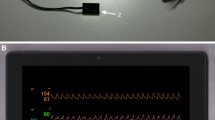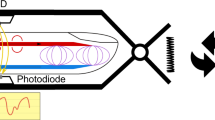Abstract
Objective
To evaluate the in vivo performance of a continuous, intra-arterial, multiparameter blood-gas sensor containing a thermocouple, miniaturized polarographic oxygen electrode, as well as fiberoptic pH andpCO2 sensors.
Design
Prospective, multicenter study comparing pH, PaCO2, and PaO2 measurements from the intraarterial sensor with those obtained from a conventional, laboratory blood-gas monitor.
Setting
Intensive care units in three academic medical centers.Patients: Adult ICU patients (n=26) with a clinical need for a radial artery catheter and frequent monitoring of arterial blood gases for ≥3 days.
Interventions
All patientys had the multiparameter intra-arterial sensor placed through a 20-gauge catheter into the radial artery. Every 4 h, or more frequently if clinically indicated, a blood-gas sample was withdrawn from the radial artery catheter and sent to the laboratory for analysis using a conventional laboratory bloodgas analyzer. Immediately pior to withdrawal of the arterial blood, values for pH, PaCO2, and PaO2 from the multiparameter intra-arterial sensor were recorded.
Measrements and main results
The multiparameter sensor was placed into 26 patients. In 7 of the patients, premature discontinuation of monitoring was necessary because of dampening of the pressure tracing, difficulty in withdrawing blood from the arterial catheter, or bending of the extra-arterial fiberoptic channel owing to the cable being inadequately secured (mean monitoring time in these 7 patients: 40.6±25.7 h). In the other 19 patients, monitoring was continued until no longer clinically indicated. In these patients, a total or 341 data sets was collected, with the average length of monitoring being 69.9±37.9 h (range 22.0 to 57.9 h). Comparison of the sensor values with those from the bloodgas analyzer showed bias and precision values of 0.006 and 0.026 for arterial pH−1.19% and 12.54% for PaO2, and 1.28 mmHg and 2.48 mmHg for PaCO2, respectively. No complications were associated with the intra-arterial sensor.
Conclusions
Clinical performance of this intra-arterial, multiparameter blood-gas sensor demonstrated stability, consistency, and accuracy comparable to laboratory blood-gas analyzers. The present multiparameter, intravascular
Similar content being viewed by others
References
Chernow N, Salem M, Stacey J (1991) Blood conservation: a critical care imperative. Crit Care Med 19: 313–314
Maukkassa FF, Rutledge R, Fakhry SM et al. (1991) ABGs and arterial lines: the relationship to unnecessarily drawn artierial blood gas samples. J Trauma 30: 1087–1095
Shapiro BA, Cane RD (1989) Blood gas monitoring: yesterday, today, and tomorrow. Crit Care Med 17: 573–581
Fleisher M, Schwartz ML (1990) Strategies of organization and service for the critical care laboratory. Clin Chem 36: 15571–1561
Abraham E, Oye RK, Smith M (1984) Detection of blood volume deficits through conjunctival oxygen tensioin monitoring. Crit Care Med 12: 931–934
Abraham E, Fink S (1986) Cardiorespiratory and conjunctial oxygen tension monitoring during resuscitation from hemorrhage. Crit Care Med 14: 1004–1009
Bratanow N, Polk K, Bland R, Kram HB, Lee TS, Shoemaker WC (1985) Continuous polarographic monitoring of intra-arterial oxygen in the perioperative period. Crit Care Med 13: 859–862
Pfeifer PM, Pearson DT, Clayton RH (1988) Clinical trial of the continucath intra-arteial oxygen monitor. Anesthesia 43:677–682
Green G, Hassell K, Mahutte K (1987) Comparison of arterial blood gas with continuous intra-arterial and transcutaneous pO2 sensors in adult critically ill patients. Crit Care Med 15: 491–494
Whar J, Tremper K (1994) Continuous intravascular blood gas monitoring. J Cardiothorac Vasc Anersth 8: 342–345
Shapiro BA, Chomka CM (1989) Preliminary evaluation of an intra-arterial blood gas system in dogs and humnas. Crit Care Med 17: 455–460
Larson CP, Divers GA, Chomka CM (1991) Continuous monitoring of PaO2, PaCO2, and pH in surgical patients. Cit Care Med 19: S25
Mahutte K, Sassoon SH, Mura JR et al. (1990) Progress in the development of a fluorescent intravascular blood gas system in man. J Clin Monit 6: 147–157
Abraham E., Markel DR, Fink S, Ehrlich H, Tsang M, Smith M, Meyer A (1985) Continuous measurement of intravascular pH with a fiver optic sensor. Anesth Analg 64: 731–736
Zimmerman JL, Dellinger RP (1993) Initial evaluation of a new intra-arterial blood gas system in humans. Crit Care Med 21: 495–500
Paratrend 7 operating instructions (1993) Biomedical Sensors, Malvern, Pennsylvenia, USA, pp 6–18
Clutton-Brock TH, Fink S, Markle D, Luthra AJ, Hendry SP (1994) The evaluation of a new intravascular blood gas monitoring system in the pig. J Clin Monit 10: 387–391
Venkatesh B, Clutton Brock TH, Hendry SP (1994) A multiparameter sensor for continuous intra-arteral blood gas monitoring: a prospective evaluation. Crit Care Med 22: 588–594
Bland JM, Altman DG (1986) Statistical methods for assessing agreement between two methods of clinical measurement. Lancet I: 307–310
1992 Interlaboratory comparison program surveys manual. III. Clinical chemistry. College of American Pathologists, pp 28–29
HCFA/CLIA proficiency testing requirements for analytic qualtiy (1992) Federal Register 57: 70002–70186
Shapiro BA, Mahutte CK, Cane RD, Gilmour IJ (1993) Clinical performance of a blood gas monitor: a prospective, multicenter trial. Crit Care Med 21: 487–494
Hansen JE, Jensen RL, Casaburi R, Crapo RO (1989) Comparison of blood gas analyzer biases in measuring tonometered blood and a fluorocarboncontaining, profinicency-testing material. Am Rev Respir Dis 40: 403–409
Hansen JE, Vasaburi R, Crapo RO, Genes R (1990) Assessing precision and accuracy in blood gas proficiency testing. Am Rev Respir Dis 141: 1190–1193
Mahoney JJ, Harvey JA, Wong RJ, Van Kessel AL (1991) Changes in oxygen measurements when whole blood is stored in iced plastic or glass syringes. Clin Chem 37: 1244–1248
Hansen JE, Feil MC (1988) Blood gas quality control materials compared to tonometered blood in examining for interinstrument bias in pO2. Chest 94: 49–54
National Committe for Clinical Laboratory Standards (1989) Blood gas prenalytical considerations: specimen collection, calibration, and controls. Tentative guidelines. NCCLS publication C27-T. Villanove, Pa
Uchida T, Makita K et al. (1994) Clinical assessment of a continuous intra-arterial blood gas monitoring system. Can J Anaesth 41: 65–70
Barker SJ, Hyatt J (1994) Continuous measurement of intra-arterial pH, PaCO2, and PaO2 in the operating room. Anesth Analg 70: 43–48
Metzger LF, Metzger LF, Stauffer WB, Krupinski AV, et al. (1987) Detecting errors in blood gas measurement by analysis with two instruments. Clin Chem 33: 512–517
Scuderi WB, MacGregor DA, Bowton DL, Harris LC, Andeson R, James RL (1993) Performance characteristics and interanalyzer variability of pO2 measurements using tonometered human blood. Am Rev Respir Dis 147: 1354–1359
Russel J, Joel M, Hudson R, Mangano D, Schlobohm R (1983) Prospective evaluation of radial and femoral artery catheterization sites in critically ill adults. Crit Care Med 11: 936–939
Soderstrom C, Wasserman D, Dunham CM, Caplan ES, Coweley RA (1982) Superiority of femoral artery monitoring. A prospecitve study. Am J Surg 114: 309–312
Author information
Authors and Affiliations
Rights and permissions
About this article
Cite this article
Abraham, E., Gallagher, T.J. & Fink, S. Clinical evaluation of a multiparameter intra-arterial blood-gas sensor. Intensive Care Med 22, 507–513 (1996). https://doi.org/10.1007/BF01712177
Received:
Accepted:
Issue Date:
DOI: https://doi.org/10.1007/BF01712177




